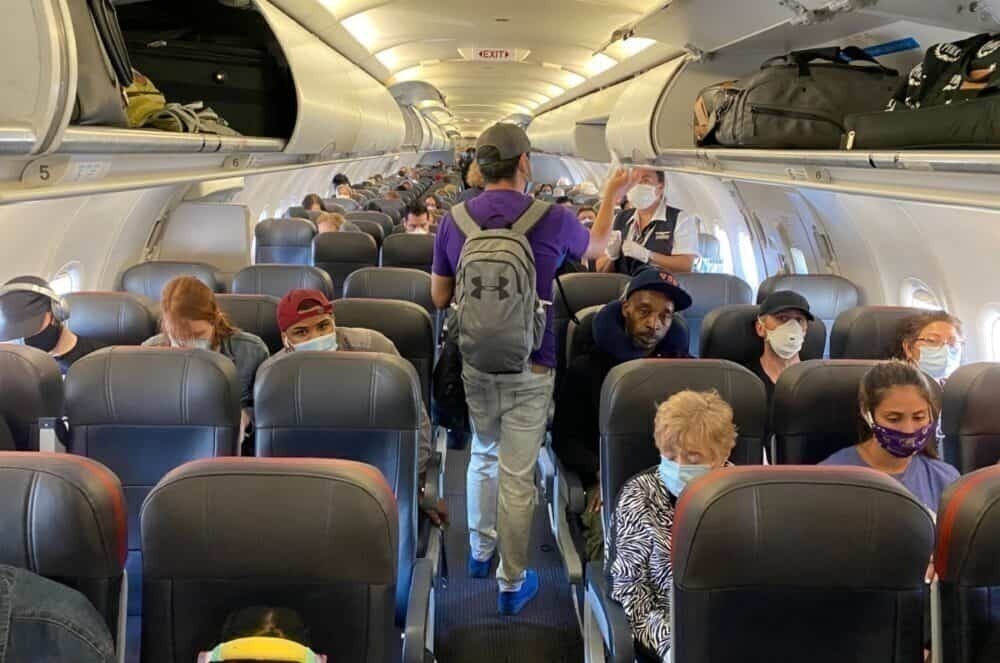A number of US airlines have committed to keeping the middle seat free, at least for the short term. Others are allowing passengers to switch flights if their booked service is looking too full. In the long term, this is not sustainable; if we want empty middle seats, someone has to pay. So should US carriers ask passengers to foot the bill?

The new normal
Social distancing is fast becoming the new normal, in every aspect of our lives. While there are some discrepancies in the actual amount of distance being recommended around the world, we’re all getting used to being a bit further away from others. On aircraft, that’s a problem.
Some airlines have already committed to keeping the middle seat block for a while. Delta will not sell middle seats before September, while JetBlue, Southwest, and Alaska Airlines are all committed to a middle seat block through July. Other airlines aren’t blocking the seat per se, although American and United are allowing passengers to change flights if it’s more than 70% full. None of the other US carriers, at this time, are limiting booking.

While leaving the middle seat free doesn’t necessarily provide enough distance anyway, it does go some way to restoring passenger confidence in air travel. In the long run, however, this is an expensive proposition for airlines.
Stay informed: Sign up for our daily aviation news digest.
The profit problem
Although some airlines are committed to blocking the middle seat in the short term, this is largely achievable due to naturally lower load factors and, of course, the support of the CARES Act funding. Long term, this would be unsustainable.
An assessment by Florida Panhandle using airline’s SEC filings showed where the break-even point of load factor would be on major US airlines. For American, it was 78.9%, for United 75.6%. For Delta is was 74.2% and for Southwest 72.5%.
Blocking the middle seat would mean a maximum load factor of 66% if every other seat on the plane was sold and occupied for the flight. At this load factor, American would lose over $5,000 on every flight, United would lose $3,600, Delta $3,400, and Southwest $2,300. And that’s not the only problem.

According to CarTrawler’s research, major US airlines earned 15.2% of their revenue from ancillary sales; things like extra baggage, seat assignments and buy onboard products. While some of those products are still for sale, things like buy onboard services have, in many cases, been scrapped, as airlines aim to limit interactions between crew and passengers.
This double whammy of lost revenue means keeping middle seats vacant without any charges being levied is wholly unsustainable, particularly once the CARES Act funding expires.
Who should pay for the middle seat to be blocked?
If airlines can’t afford to keep the middle seat empty for free, who should cover the cost? When Frontier decided to sell the middle seat for $39 to its passengers for social distancing purposes, there was an epic backlash. So much so that, just days after introducing the ‘More Room’ policy, Frontier withdrew it.
American Airlines’ workers union has laid the responsibility at the feet of the US Government. It says that leaving the middle seat free will cost US airlines $1.9bn a month and wants the state to pay. The APA says that keeping the middle seat free is essential to restoring traveler confidence, arguing that the economic stimulus would make it a good investment.

Whether the US government goes for this proposal remains to be seen. In the meantime, passengers can only be guaranteed no neighbor if they fly with one of the airlines keeping the seat blocked voluntarily, or if they buy one themselves.
Does the seat need to be blocked at all?
There are strong arguments over the efficacy of blocking the middle seat at all. Not having an immediate neighbor doesn’t leave passengers even a meter away from the next closest passenger, so social distancing is still not achieved. The International Air Transport Association (IATA) has opposed social distancing, saying that masks are a far more effective measure.
Airbus and Boeing have gone to great lengths to explain the safety of aircraft cabin air circulation. The natural vertical circulation means there is little movement of air between passengers; this could be further enhanced by some new products currently in development. Advanced, hospital-grade HEPA filtration means the recirculated air is as clean as it would be in an operating theatre.

Along with this, passenger seat innovations promise to bring more protection to airline passengers, although these will likely take some time to filter through to today’s cabins. In the short term, naturally low load factors will make social distancing possible in many situations. In the long run, someone will need to pay, or we just have to accept the fact that social distancing is impossible in an aircraft.
What do you think? Should middle seats be kept empty in the post-COVID world? Or should we just accept that it’s not a sustainable measure? Let us know in the comments.
"middle" - Google News
June 25, 2020 at 05:59PM
https://ift.tt/3ezEKvY
Should US Airlines Charge Passengers To Keep The Middle Seat Free? - Simple Flying
"middle" - Google News
https://ift.tt/2MY042F
Shoes Man Tutorial
Pos News Update
Meme Update
Korean Entertainment News
Japan News Update
No comments:
Post a Comment